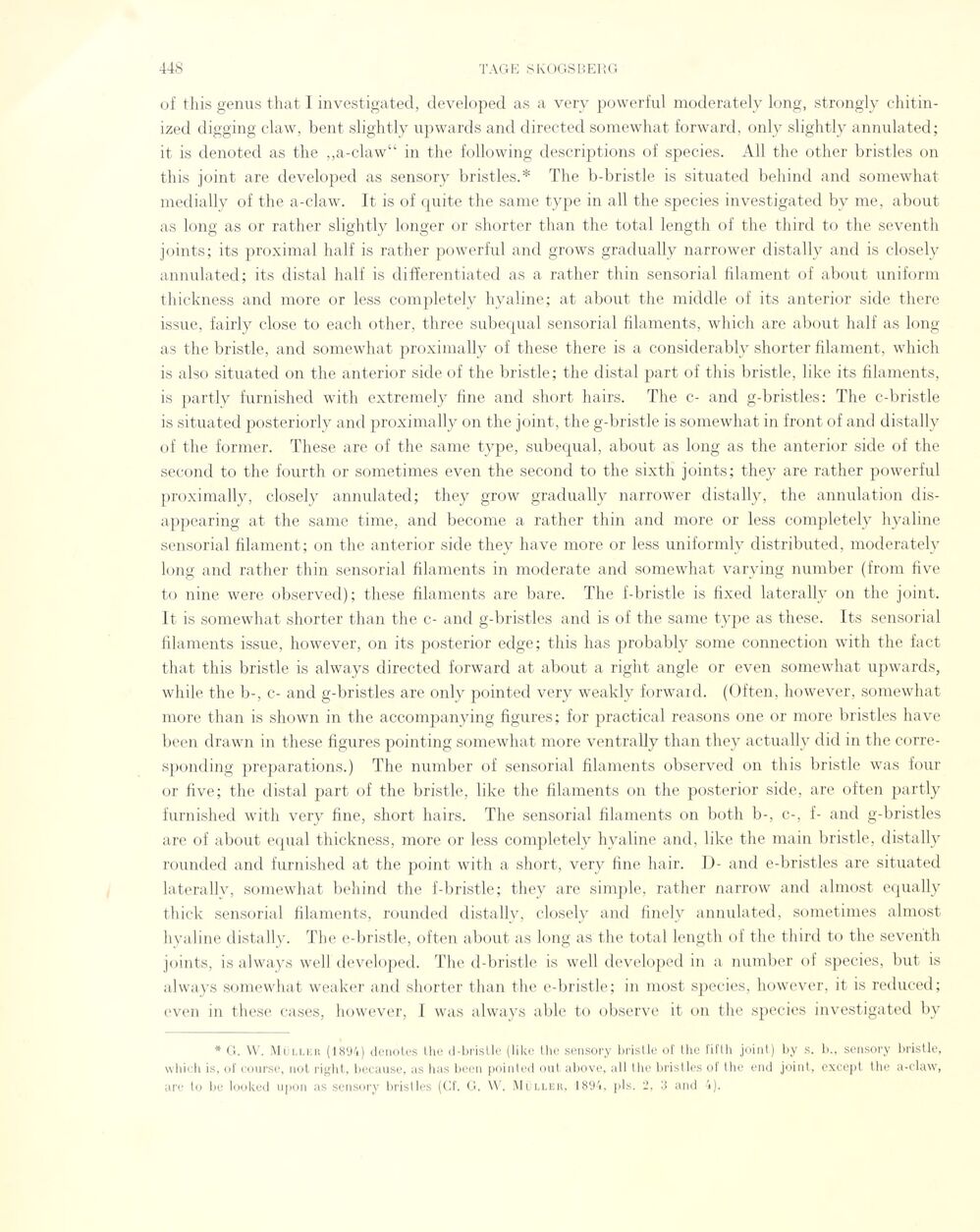
Full resolution (JPEG) - On this page / på denna sida - Sidor ...

<< prev. page << föreg. sida << >> nästa sida >> next page >>
Below is the raw OCR text
from the above scanned image.
Do you see an error? Proofread the page now!
Här nedan syns maskintolkade texten från faksimilbilden ovan.
Ser du något fel? Korrekturläs sidan nu!
This page has never been proofread. / Denna sida har aldrig korrekturlästs.
of this genus that I investigated, developed as a very powerful moderately long, strongly
chitin-ized digging claw, bent slightly upwards and directed somewhat forward, only slightly annulated;
it is denoted as the ,,a-claw“ in the following descriptions of species. All the other bristles on
this joint are developed as sensory bristles.* The b-bristle is situated behind and somewhat
medially of the a-claw. It is of quite the same type in all the species investigated by me, about
as long as or rather slightly longer or shorter than the total length of the third to the seventh
joints; its proximal half is rather powerful and grows gradually narrower distally and is closely
annulated; its distal half is differentiated as a rather thin sensorial filament of about uniform
thickness and more or less completely hyaline; at about the middle of its anterior side there
issue, fairly close to each other, three subequal sensorial filaments, which are about half as long
as the bristle, and somewhat proximally of these there is a considerably shorter filament, which
is also situated on the anterior side of the bristle; the distal part of this bristle, like its filaments,
is partly furnished with extremely fine and short hairs. The c- and g-bristles: The c-bristle
is situated posteriorly and proximally on the joint, the g-bristle is somewhat in front of and distally
of the former. These are of the same type, subequal, about as long as the anterior side of the
second to the fourth or sometimes even the second to the sixth joints; they are rather powerful
proximally, closely annulated; they grow gradually narrower distally, the annulation
dis-appearing at the same time, and become a rather thin and more or less completely hyaline
sensorial filament; on the anterior side they have more or less uniformly distributed, moderately
long and rather thin sensorial filaments in moderate and somewhat varying number (from five
to nine were observed); these filaments are bare. The f-bristle is fixed laterally on the joint.
It is somewhat shorter than the c- and g-bristles and is of the same type as these. Its sensorial
filaments issue, however, on its posterior eclge; this has probably some connection with the fa et
that this bristle is always directed forward at about a right angle or even somewhat upwards,
while the b-, c- and g-bristles are only pointed very weakly forward. (Often, however, somewhat
more than is shown in the accompanying figures; for practical reasons one or more bristles have
been drawn in these figures pointing somewhat more ventrally than they actually did in the
corre-sponding préparations.) The number of sensorial filaments observed on this bristle was four
or five; the distal part of the bristle, like the filaments on the posterior side, are often partly
furnished with very fine, short hairs. The sensorial filaments on both b-, c-, f- and g-bristles
are of about equal thickness, more or less completely hyaline and, like the main bristle, distally
rounded and furnished at the point with a short, very fine hair. D- and e-bristles are situated
laterally, somewhat behind the f-bristle; they are simple, rather narrow and almost equally
thick sensorial filaments, rounded distally, closely and finely annulated, sometimes almost
hyaline distally. The e-bristle, often about as long as the total length of the third to the seventh
joints, is always well developed. The d-bristle is well developed in a number of species, but is
always somewhat weaker and shorter than the e-bristle; in most species, however, it is reduced;
even in these cases, however, I was always able to observe it on the species investigated by
* G. W. Müller (1894) denotes the d-bristle (like the sensory bristle ol the fiflh joint) by s. b., sensory bristle,
which is, of course, not right, because, as has been pointed out above, all the bristles of the end joint, except the a-claw,
are to be looked upon as sensory bristles (Cf. G. W, Müller, 1894, pis. 2, 3 and 4),
<< prev. page << föreg. sida << >> nästa sida >> next page >>